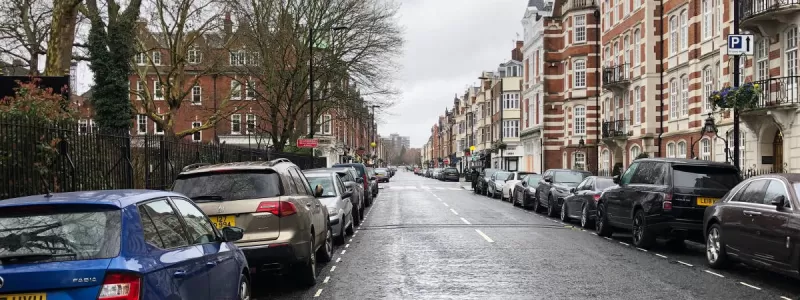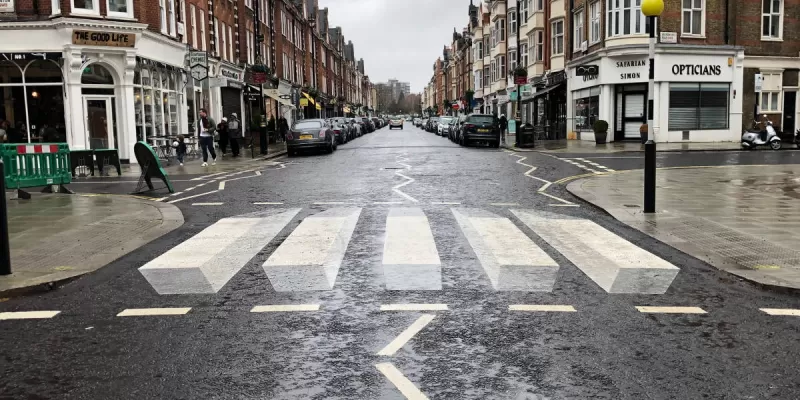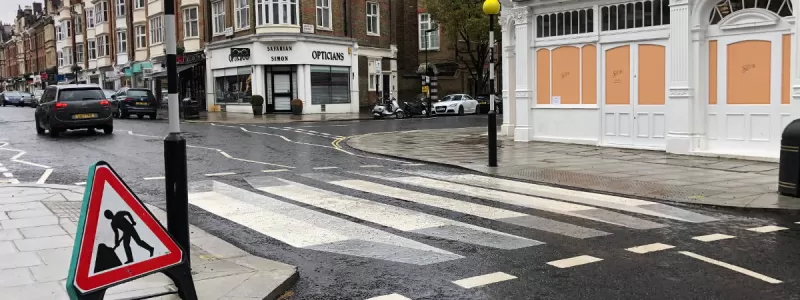The humble zebra crossing has been almost unchanged since the early 1950s. Can it be improved with an optical illusion?
Westminster City Council certainly think so. On St John's Wood High Street, just round the corner from Lord's Cricket Ground and London Zoo, they were faced with the problem of traffic passing through at relatively high speed, and children heading to and from a nearby school didn't feel safe crossing the road.
The solution? To have their highway maintenance contractors install a zebra crossing that is specially designed to make it look like a series of five white blocks in the roadway, with the intention that drivers will hit the brakes while they work out what's going on. Similar fancy paintwork has been tried before now in India, China, Iceland and France - but this appears to be the first time it's come to the UK. So, naturally, Roads.org.uk has been to St John's Wood to have a look.
St John's Wood High Street is a fairly typical, affluent Westminster street, with tall brick-built mansion blocks and, further along, some high-end boutique shops and fancy tea rooms. It's ruler straight, reasonably wide despite having cars parked on both sides, and it's no surprise a lot of people drive along here at 30 - or, perhaps, faster.
What does it look like?
Now, of course, there's something different and unexpected to slow you down. It's not that unexpected, though, because the first thing you'll notice as you approach it is a red sign warning you that there's a "3D crossing" up ahead.
The crossing itself has five white stripes across the width of the road, as you'd expect, and the normal zig-zag lines on the approaches. Around the stripes, though, are some additional blocks of grey paint that have been carefully laid out so that, as you approach on the roadway, the stripes look like they're white blocks lying in the road. The illusion is quite clever, because it works in both directions. It looks best when you're standing in the middle of the road, close to the eyeline of a car driver, though of course if you want to experience this yourself, I cannot recommend that you actually go and stand in the middle of the road.
From the side, it looks rather strange - just some oddly-shaped grey blocks around the outside of the white stripes.
Does it work?
That is the big question, and presumably Westminster City Council will be keeping an eye on their new crossing to see what happens. Standing at the roadside for a few minutes, and observing the Sunday morning traffic, though, my impression was: not really.
Traffic passing through the crossing was reasonably light and looked to be moving at about 30mph, as you'd expect on a street that looks like this. Nobody appeared to be slowing or adjusting their course when they approached the crossing, and there was certainly no evidence of anyone being uncertain enough that they used their brakes.
Partly, that's because it's not a terribly convincing illusion, and it's clearly just paintwork. It's perhaps also because the illusion is made with grey paint on a grey road surface and, in the March rain, it wasn't actually obvious that there was anything on the road beside the usual white stripes.
You can see in some of the pictures on this page how the light on the wet road surface makes it rather indistinct. It's also clear that the stark black and white stripes of a zebra crossing have been blurred by surrounding them with grey paint. From some angles and in some lights, the stripes aren't very clear at all.
A further consideration is that this street carries almost entirely local traffic - anyone travelling through the area will use the A41 Wellington Road, which runs parallel one block to the west. That means that the overwhelming majority of the drivers who will pass through this crossing will see it for the first time in the couple of weeks after it's installed, and will be entirely familiar with it after that. It's not an illusion that is going to fool anyone twice, so most vehicles passing through here for the lifetime of this crossing will be driven by people who will just treat it like any other zebra crossing.
Finally, in terms of improving the safety of children crossing the road here, and reducing the speed of motor traffic, it might be worth asking whether the installation of one zebra crossing is likely to cause drivers to negotiate this street more slowly than before, when nothing else about its appearance has changed.
Whatever the pros and cons, though, this is an experiment, and in the name of improving road safety it's hard to argue against the trialling of a potentially useful idea. Westminster do seem to be taking the trial seriously - with plenty of publicity, and with pneumatic tubes installed across St John's Wood High Street to measure the effect the new crossing has on vehicle speeds. The evidence they collect, from before the crossing was installed and over the length of the trial, will be a lot more conclusive than a few minutes spent watching cars on a rainy Sunday morning in March.
The trial is set to run for nine to twelve months, so we will have to see if the strange new stripes stay after that, or whether this zebra ends up losing its third dimension. And in the meantime, St John's Wood High Street is about to become very popular on Instagram.
Comments
I would like to think a large highway authority, with the DfT in their district, wouldn't be so silly as to do this without authorisation, but sadly experience suggests they might well have done so. I would also hope that the DfT would have refused authorisation, again.....
A possibly larger problem is that, off the top of my head, the zig zags are prescribed (and directly effective without an order, I think) only for use at certain locations, one of which is a zebra controlled area. This isn't a zebra crossing (because the traffic sign is not one prescribed by item 52, part 2, schedule 14) so the zig zags are not capable of prohibiting stopping on them. So this is the only place in Westminster with 24 hour free parking for all, there being no traffic sign which conveys a prohibition on waiting, loading, or stopping.
Unrelated, but also problematic: that tactile paving does not stand out from the rest of the paving. I know grey is popular in London but it is still supposed to be easy to see. Maybe the idea is that nobody is supposed to know what's going on here!
I don't think you understand who the tactile paving is for. It's for partially blind and blind people. They're not supposed to see it, they're supposed to feel it, hence the bumps.
Not quite - the tactile paving is also supposed to be a contrasting colour to the surrounding pavement to make the crossing point easier to identify for people who are partially sighted. There's even a standard colour code that highway authorities are supposed to follow - yellow for uncontrolled crossings and pink or red for signalised crossing points. Installing tactile paving that is the same colour as the surrounding pavement is less helpful to partially sighted people and goes against advice in the relevant design guidelines. There's more information on the RNIB website.
Not the first 3D road markings in London. The A117 in North Woolwich has these ersatz speed cushions that look quite convincing from afar... only problem is they're both facing the same way for some reason which makes this look like a one-way street!
Is that why there are directional arrows on what would be the approach side if it WAS a one-way street?
I highly doubt that anybody paying attention would be fooled by it the first time, honestly. Complete waste of time.
Certainly doesn't dissuade the many drivers of high performance cars coming down the High Street way too fast, or the drivers who noisily accelerate on the High Street and surrounding roads late at night. The "experimental" 20mph zone nearby also hasn't made much of a difference due to lack of enforcement.
New zebra in the location: useful. But needed to include a proper speed table (and the zebra at other end of high street also upgraded). Or at least camera enforced zebra and new 20mph restriction for High Street also camera enforced.
I agree there is too much grey on either side of the white bars which ironically makes the crossing less visible. The current depiction assumes you are driving in the middle which should not be the usual experience.
If the grey was only at the ends of the bars (as shown on the middle bar) it would be less artistically correct.but more effective. The end grey bit could also be tapered to give the illusion that it rises rather than being a "kerb".
Perhaps they should have done the Abbey Road zebra crossing. Would have made an even better album cover.
More to the point - if a driver missed the notice and WAS convinced that they were about to run into a concrete block, jammed on the brakes and was run into by a following vehicle, then issues of liability would arise. To me, it's even dafter than not putting reflectors on the front edge of traffic islands (or pedestrian refuges, or whatever they're called) which stick out considerable beyond the (supposedly) illuminated pillar.
'3D' text signs on roads (e.g. STOP) were trialled and abandoned as under certain conditions some drivers actually saw them as obstructions to the carriageway and slowed down or stopped, causing a hazard.
Let's see if someone at night thinks there are concrete blocks on the road and does an emergency stop.
Add new comment
Sources
- "Whoa! North London Just Got A 3D Zebra Crossing", Londonist, 01/03/19.
- "'UK's first' 3D zebra crossing created in St John's Wood", BBC News, 28/02/19.
- "Would these floating 3D zebra crossings slow you down?", BBC Three, 01/11/17.






Illegal. Not in Regulations. Not approved or authorised by the Department for Transport. Waiting for the first accident or collision and subsequent court case.